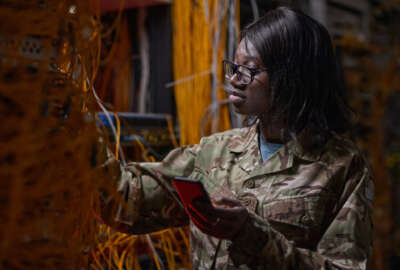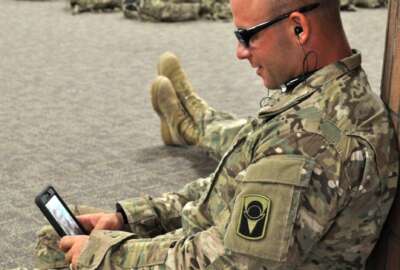Army nearly ready to move thousands of users to BYOD, virtual desktop programs
Both pilots rely heavily on the groundwork already laid by the Army's Enterprise Cloud Management Agency, and are expected to start onboarding large numbers of ...
Best listening experience is on Chrome, Firefox or Safari. Subscribe to Federal Drive’s daily audio interviews on Apple Podcasts or PodcastOne.
The Army is just weeks away from finally letting a significant cadre of soldiers and employees use personal mobile devices to connect to government systems. It’s part of a much larger endeavor to create a “unified network” that relies much more heavily on cloud technologies, zero trust principles and commercial solutions.
The Army has been engaged in serious testing of technologies to underpin a bring-your-own-device strategy (BYOD) since at least last year. Now, officials are ready to roll it out to an initial user base of potentially thousands of soldiers and Army civilians.
The pilot project should be underway within the next 45 days, said Lt. Gen. John Morrison, the Army’s deputy chief of staff for command, control, communications, cyber operations and networks.
“Much like you do in the commercial sector, you can now use your personal device, but we will put a secure capability on it that allows you to log back into the Army network and conduct official business,” he told reporters this week. “Think of the operational effectiveness that will come with that, and think of the possible economic or fiscal efficiencies that we potentially could get.”
Morrison said the first pilot users will be concentrated in National Guard and Army Reserve, but active duty soldiers will be part of the mix fairly soon. After that, the pilot will expand to units stationed outside the United States. It’s not yet clear how many total users will be involved, but officials have previously said they hoped to involve up to 20,000 in the pilot program by the end of this year.
“The way that we generally approach this is that we start by onboarding what we call ‘champions,’ and those are both technical users and just regular users,” he said. “The reason we do that, and we learned this when we were implementing Army 365, is it produces just amazing tactics, techniques and procedures we can use when we start doing the broader onboarding. It really just makes it so much easier.”
The Army has been discussing the BYOD concept for years, and Morrison said part of the holdup has been ensuring the solution the Army adopts has adequate security. He said officials are now confident that that’s the case.
“If we don’t bake in cybersecurity at the very front end and do it continuously, we’re going to open up some holes in our swing. That’s always been one of the big concerns about anybody using their personal device to conduct business,” he said. “But since it’s done in a virtualized environment, that’s hosted up in the cloud, it’s very secure. We’ve had this red teamed ad nauseam by elements outside of the Department of the Army, and the assessments that have come back have said the path that we’re on is one of the most mature that’s out there. It’s taken us a while to get to this point, both from a policy perspective and from a building out the environment, but we are right on the cusp of implementation.”
Meanwhile, the same foundations the Army has laid to support access to commercial cloud are also going to let it start testing virtualized desktops. Both efforts are being managed by the Army’s Enterprise Cloud Management Agency.
A separate pilot to prove out Microsoft Azure virtual desktops will also start by early October. And there, too, the initial focus will be the Guard and Army Reserve, Morrison said.
“We’re targeting reserve centers that may be out in remote areas where we may not want to extend military infrastructure and communications. And we can now leverage this virtual infrastructure, and it’ll be just like they were at Fort Bragg, Fort Gordon, you pick a post,” he said. “You’re now able to buy a relatively dumb device, log it into this environment, and it’s almost as if you have your own personal desktop. We see this from a mobility perspective, but we also see an application to operationalize this at our installations.
Indeed, the success of the virtualization pilots could have big implications for what the Army ultimately decides it needs to do to modernize the aging IT infrastructure on its bases.
Earlier this year, the Army ended another pilot program called Enterprise IT as a Service, designed to test the concept of letting a single vendor deliver networking and end user devices to a particular base.
Morrison said the Army learned a lot from those pilots, but there’s now a greater push for modernization approaches that are much less base-centric, and much more focused on enterprise capabilities delivered from the cloud.
“We’re shifting, because the environment is shifted on us,” he said. “If you looked at where we were at 12 years ago, buying switches for every floor of every building and building out that topology made a lot of sense. Think about the advent of advanced wireless, think about 5G. Think about virtualization and how that’s matured.”
For unclassified systems on its garrisons, Morrison said the Army is thinking about its next steps under the umbrella of an effort called NIPRNet Optimization. But he said those unclassified networks are a relatively low priority compared to the work the Army needs to do to reimagine the connectivity of its classified systems.
So, for at least the next year or two, more network modernization energy is going be devoted to ensuring the service’s unified network vision works at the classified level, and modernizing those systems.
“We needed to do that. We’re operating against very thinking adversaries, and we needed to rapidly increase our secure capabilities,” Morrison said. “That’s a key part of this notion of a unified network: how do you get the secure architecture out there, so that it’s just absolutely seamless, whether you are in garrison or at the tactical edge? We’ll build that out here over the next 24 to 36 months, but we’re already onboarding users onto it, because it’s that critical.”
Copyright © 2024 Federal News Network. All rights reserved. This website is not intended for users located within the European Economic Area.
Jared Serbu is deputy editor of Federal News Network and reports on the Defense Department’s contracting, legislative, workforce and IT issues.
Follow @jserbuWFED






